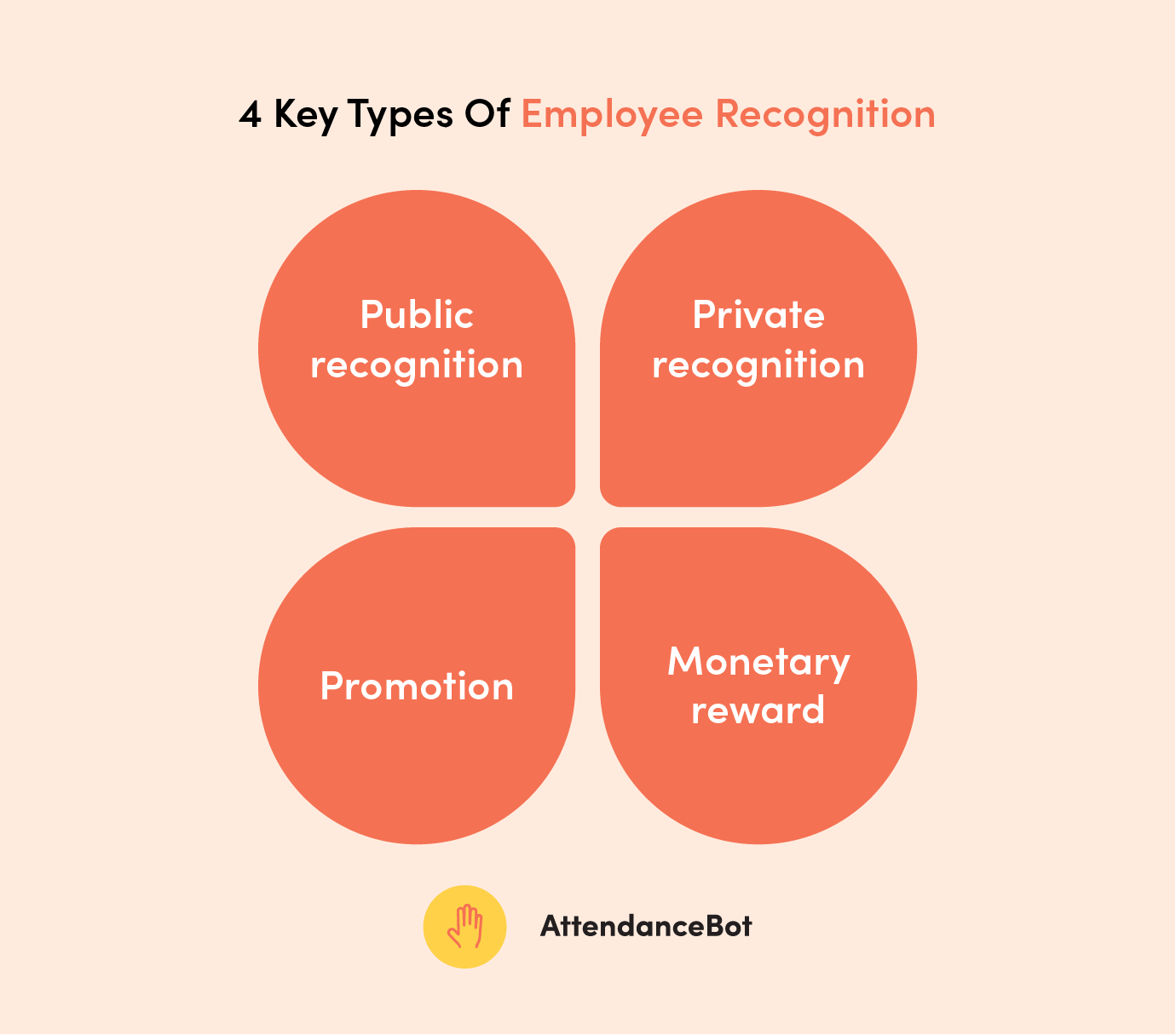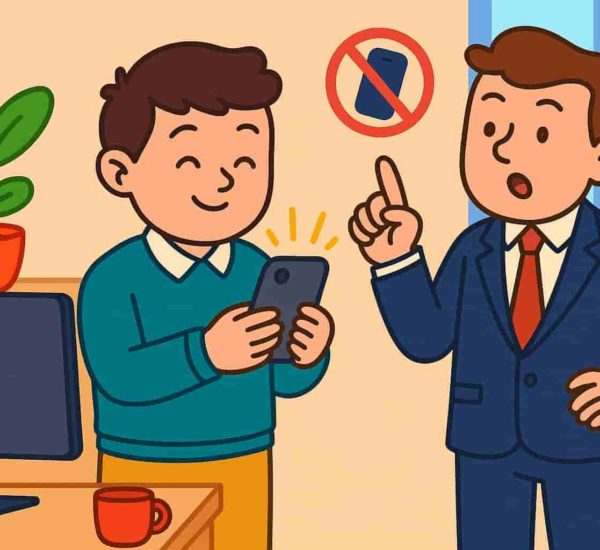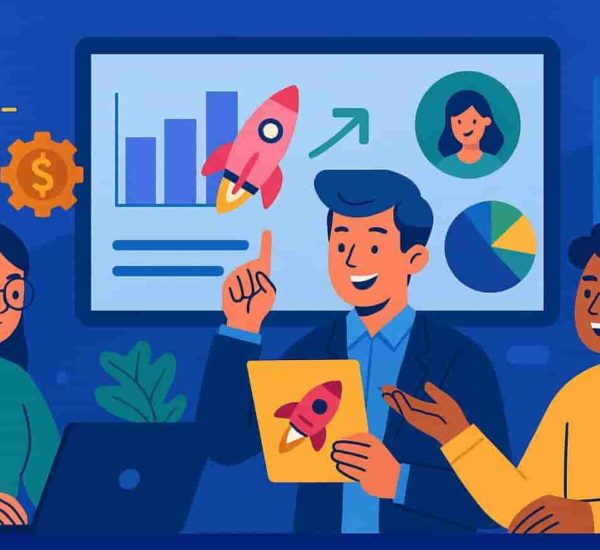A special shout out for a job well done, a public acknowledgment of a performance that clinched a deal, or even a special bonus; employee recognition can be in any form. From verbal appreciation to financial compensation, employee recognition is a technique that is valuable and integral to the organization.
Studies and surveys suggest that organizations that have implemented an employee recognition program, have seen a 24% improvement in the quality of work. They have also noticed a 27% reduction in absenteeism and a 10% reduction in employee churn.
What is employee recognition?
In simple terms, employee recognition is expressive acknowledgment and appreciation of an employee’s work which reinforces and encourages a certain employee behavior or outcome. It’s imperative that the employee recognition programs should be designed such that they give a competitive edge to your organization.
Employee recognition goes beyond managers commending a subordinate in a 1:1 setting. It is a sentiment that should flow across the organization. While the most common form of recognition – monetary compensation – flows from a higher level of hierarchy to a lower one, we are here to explore the numerous other ways to recognize an employee beyond this obvious one.
Why do we need to go beyond monetary compensation? Besides the fact that this is a blunt instrument, two big reasons come to mind. First, this is a very expensive form of recognition and is a zero-sum game. Every year you have a set budget to give monetary rewards so what you give to Paul, you cannot give to Paula.
Second, everyone appreciates money but like with anything in life this also follows the ‘law of diminishing returns’. Therefore you need a variety of tools to recognize people on your team, especially ones that are relatively inexpensive and can, therefore, be granted more generously to a larger number of people without necessarily creating a competitive environment in the office.
What are the benefits of Employee Recognition?
Employee recognition or giving employee rewards can prove extremely beneficial in increasing employee productivity and organizational performance as a whole. Here’s how.
1. Boosts employee morale
Employee recognition ensures that your employee feels encouraged. An appreciated and acknowledged person performs better. This gives a necessary boost to employee’s productivity which in turn works better for the business.
2. Gives employees a sense of purpose
Employee recognition programs are curated and designed to make employees feel a part of the team and the organization. An inclusive environment can do wonders to the attitude of employees. Not only do they feel encouraged, but this makes them identify with the organization’s vision and mission, thus giving them a sense of purpose. Employee awards never go in vain.
3. Improves employee engagement
Rewards and recognition, gift ideas for employees, and other forms of employee recognition are meant to improve employee engagement. The relationship between the employee, employer, and the organization improves, thus increasing employee’s dedication towards work and loyalty towards the business.
4. Increases employee motivation

For any successful organization, it is imperative to have employee motivation in place. Employee motivation, in turn, comes from employee recognition. Make sure that your employee recognition programs are designed in a way that motivates your employees.
If you’re looking for ways to improve employee motivation, don’t forget to read our guide here.
5. Reduces turnover and attrition
Excellent employee gift ideas and good employee recognition programs inculcate a sense of loyalty within the employees. This, in turn, reduces the attrition rate and helps organizations retain human resources for long, even in these fast-changing times.
6. Better teamwork
Peer recognition is another form of employee recognition which is imperative towards the employee growth and further for a business boom. When peers complement each other they boost each other’s morale. This also increases the bond within the team, which makes their work faster, more coordinated, and more efficient. Peer recognition is an extremely useful employee recognition tool and could be a part of your employee rewards program.
7. Increases employee productivity
Last but not the least, employee recognition ensures an assured increase in employee productivity. A motivated and sated employee gives his or her 100% to the organization, thereby exponentially contributing to the growth of the business.
What makes an employee recognition program successful is that it should be innovative, inventive, and implemented the correct way. Your employee recognition programs and employee awards should be customized to suit your organization’s culture and norms, and cannot simply be a playbook that you get off the shelf. It should even differ by teams.
While a sales team typically tends to have a more competitive culture and recognition is typically more individual-oriented, engineering teams tend to be more collaborative where recognitions are typically done at a team level.
According to a study, 90% of the companies with a value-based employee recognition program noticed higher employee engagement, leading to higher productivity. It also led to higher retention rates.

What are the types of employee recognition?
Workforce recognition comes in different forms. One way to think about it is the format or the forum in which an employee is recognized.
Verbal appreciation or praise
A verbal praise often comes in the form of an off-hand compliment, a praise for a task just on-the-go, and more. When praises float around in the team, amidst the members, it binds them together and they know they have got each other’s back.
Written appreciation or praise
This can come in the form of thank-you notes, emails, or even small tokens with messages. Written notes are beautiful in the way that these are personalized, memorable, and tangible.
Employee awards
Another tangible form of staff recognition is in the form of actual awards. Many big brands and organizations conduct their own ceremonies on a large scale to felicitate the best employees, as per the category. Employee awards are a good way to recognize an employee’s efforts.
Whatever may be the type of employee recognition, the crucial point is that it should exist and should be done often for your employees to be happy, sated, and productive.
Another way to think about staff recognition is in the following four categories:
Private recognition
This one is usually one on one but works just as effectively. Private recognition can be in the form of one-on-one interactions or in the form of private notes or emails which are directly addressed to the employees. However, this is the least effective form of employee recognition as it does not fulfill the basic tenet of being recognized in front of all.
Public recognition
This is usually in the form of awards or certificates. This kind of recognition can either be in team meetings verbally or in the form of internal awards where the employees are felicitated in a specific category for their exemplary contribution. The more tangible the award, the better and more long-lasting are its effects.

Promotion
The scope of work can be increased, or major projects can be handed over to show the trust factor. This too is quite an effective way of labor recognition. A visible change in designation is a public acceptance of employee’s capabilities and a brilliant way of recognizing his or her caliber.
Monetary
Monetary benefits in the form of bonus or incentives usually flow from a manager to an employee, to appreciate a task or performance over a certain period. However, this bonus is slightly different from the performance-based one, which is more of an employee appreciation technique. The bonuses in case of workforce recognition are more spontaneous and frequent, also mostly lesser in proportion. It’s a token.

We’ll be explaining these employee recognition examples next.
Employee Recognition ideas and examples
Employee recognition ideas should be unique. Every employee in an organization is unique with their own strengths and weaknesses. Thus, the employee recognition ideas too should be such that they facilitate efficient employee recognition programs that work across the breadth of the employees. They should reinforce good behavior and compliance with company values and discourage behaviors that undermine teamwork while also steering clear of creating new problems like people feeling jealous or being part of a rigged system. Here are some of our favorite recognition gifts for employees and employee recognition examples for you!
Handwritten notes
Nothing works better than the good-old handwritten note. A simple thanks for being an integral part of the organization or a personalized note should do the trick.
These notes can either be situation or case/client-specific or can be about general performance.
- Employee recognition example in the form of a thank-you note (specific):
I was very impressed with how you handled [difficult situations]. Thank you for reassuring [Customer Name] by sharing the details as to how we will solve the problem and the steps we will put in place to prevent this problem from occurring again. I am grateful for your easy-going manner that brings comfort to the customers and [Customer Name] loves having you on their account. - Employee recognition example in the form of a thank-you note (general): I want to recognize your years of service with [Company Name]. [#] of years is admirable! While my tenure has been much shorter, I can say that this team is better because of you. Your skills with [whatever team uses] are exceptional and I appreciate that time you take to mentor the newer team members.
Appreciation videos
Another effective technique of employee recognition is in the form of appreciation videos. The CEO can record a video addressing all the employees, and mention a few with regards to their exceptional contribution towards a project or towards the organization as a whole.
Delivering recognition at home
Another sweet form of employee recognition is this, wherein chocolates, flowers, or any such token can be sent to the employees home, via a colleague, a subordinate, or a boss. This works miraculously well when the employee is on a leave, either personal or to cater to family needs. It is a way of recognizing that ensures that the employee is missed and his efforts are indeed integral to the organization.
Tickets to an exclusive event

Every organization, peers, and managers should know of each other’s likes and dislikes. While someone may be a fan of theatre, others can enjoy a specific film star’s latest release. Then there are others who enjoy musical concerts. However, they may not attend such first shows due to professional commitments or higher costs. Surprise them with an exclusive ticket to the event they would love to attend, as a prize.
Offer professional courses
Another one from the many good employee recognition programs can be this, an educational one. You can organize professional courses which otherwise charge a fee, for free. This will not only hone the relevant skills of your employee but also elevate them professionally.
Official representation
Give your employees a chance to represent the company at conferences and events. This will be a great employee recognition exercise in itself and will boost the morale of the employee as well.
Years of service awards
One of the most common employee awards for recognition across industries has been the years of service award. Here the company simply awards based on the year-wise milestone an employee has achieved. For instance, awarded with a small memo or an acknowledgment every time they complete a year. And then adding some employee benefits to the employee rewards as they complete 5 years or more. This example of employee recognition awards is also a good reminder of how long you’ve been together.
Years of service pins
Similar to the years of service awards, you can have simple years of service pins as an employee recognition reward as well. While the concept essentially remains the same, you replace the bulky memo with a little pin that can be customized with your company’s brand and design.
Funny employee awards

If you want to make your employee recognition program more fun, consider giving out funny employee awards instead. Things that will have your employees walking out of your office grinning ear to ear. For example, you can have the ‘most likely to…..’ rewards, ‘most embarrassing moments at work’ reward, or a simple ‘you rock’ reward with a caricature that matches the employee. Humorous office awards are a great way to add some fun to space and lift the spirits!
These are some of the most effective employee recognition ideas. There are more and many in the tune of the same, you have to pick the ones that work best for your organization and your employees.
What is the best time for Employee recognition?
When should employee recognition be due? While it should be spontaneous most of the time, there are a few designated days when the recognition should be apparent.
Following is the employee recognition timeline that you should keep in mind, aside from the ongoing praise, bonuses, and employee recognition awards.
- Special days, such as anniversaries and birthdays
- Joining date and the anniversaries thereafter
- On-spot reviews and recognitions
How can you make your employee recognition programs a success?
The best way to ensure that your employee recognition programs become successful is to understand your employees. You have to make sure that your employee recognition ideas are in sync with the employee thoughts, which in turn are in tune with the vision and mission of the organization. At the end of the day, your employee recognition programs should be powerful enough to have a positive impact on both employees and the organization.
Employee recognition programs are not always about professional achievements. Personal accomplishments need to be applauded as well. Someone got married? Congratulate them. Someone became a parent? Acknowledge positively. Someone cleared a professional course with an ace grade? Acknowledge and appreciate. There are numerous small ways that can be incorporated to create successful employee recognition programs.
Here are a few ways in which you can make your employee recognition programs an absolute success:
Be fair
Unbiasedness is the key to any successful employee program, recognition or otherwise. Make sure that your personal equation or any other parameter does not come in the way of your professional acknowledgment and recognition.
Ask your employees

An isolated policy is never a successful one. The best way to create employee recognition programs would be to keep asking the employees what criteria would they want. Take their suggestions into consideration and make them feel included. Then use your judgment to create a fair and equitable recognition program.
Establish a criteria
This is the most important point. You should clearly establish the criteria for an award. What makes a performance worthy of an award? The answer to this question should be crystal clear in the heart of every employee.
Recognize and mention
Do not hand out vague employee recognition and compliments. Be precise and specific. The employee and peers should know exactly what the recognition is for.
Be prompt
A praise delayed is a praise denied. Recognize an effort when it’s visible. Be prompt with your employee recognition. The more you delay the lesser would be its effect, i.e. the ultimate increase in productivity and employee motivation.
Send a written acknowledgment
While you have verbally acknowledged and appreciated the employee’s efforts, written employee recognition should go thereafter, to make it absolute and tangible.
The traits of employee recognition cannot be deemed absolute, given it is an abstract policy. However, it only requires humane and decent efforts to make it a success.
Employee recognition may not be an easy feat to achieve, given there are actual humans involved, with constantly changing myriad of emotions therein. But once implemented correctly, employee recognition can turn out to be the biggest asset-making policy of your organization. It can turn decisions and people around, for the benefit of the business as a whole.
Now that you understand the best practices of what needs to go into a successful employee recognition and rewards program, let’s quickly go over the common stumbling blocks.
Why do many employee recognition programs fail?
Employee recognition programs like any other big organizational initiative require feedback and constant fine-tuning to succeed. It is possible or perhaps even likely that the first attempt will not succeed but by now we know how important this is so we must push through the initial failures towards the eventual success.
Here are the common failure modes:
“Employee of the month” programs
They are generally not meant for information workers or people doing creative work since they pit members of a team against each other. This actually undermines teamwork. Additionally, an “employee of the month” program typically recognizes people for doing their regular day to day work and following protocol. These types of programs are better suited for work that is repetitive where it’s easy to predict what it takes to get to the top.
Feeling of bias
If the criteria for recognition or award is too arbitrary or subjective then employees start feeling that the system is rigged against them and in fact get unmotivated.
Feeling of favoritism
If the same person gets the award often, that becomes a problem. An easy way to prevent this is to have the reward be given by a jury and the direct supervisor should not be the one involved.
Too infrequent
The recognition is most impactful if it’s immediate. A smaller instant recognition among peers can be as effective as an all-expenses-paid trip to the Bahamas at the end of the year. In short, avoid an annual program and have something more frequent.
Too vague
Employees want to know what kind of behaviors would lead to a reward. It is important to be specific when articulating the criteria for recognition. Like with other things business, even for employee recognition, “what gets measured gets done”. So for an award to be effective, the team needs to know what they need to do, exactly, to get the reward.
Too private

A reward is worth more if there is a way to show it off. You can amplify the impact of a reward by giving an opportunity for the employee to show off their achievement for peers to recognize the recognition.
Achievement only programs
If you over-index your program on the output you have a risk of missing out recognizing employees who almost made it. While output or achieving a milestone is important, it is equally important to be cognizant of the fact that sometimes even with everything done right, sometimes things don’t pan out the way we hope.
Take the current Covid-19 situation wherein a lot of initiatives that were going well suddenly stopped yielding results due to macro-economic turbulence. Recognition and rewards programs should, therefore, take into consideration the effort that went into an initiative in addition to the achievement or outcome. If the outcome is the only consideration, then the team is encouraged to play too safe and are so afraid of missing the mark that they place the mark too low. This defeats the purpose of the recognition program in the first place, which is to encourage the team to strive for higher goals.
Not quirky enough
It’s easy to check the box for instituting an employee recognition and rewards program by just instituting some financial rewards or bonuses. While that’s a good start, it’s not good enough. Try to make the program multifaceted and include different types of recognitions we already discussed.
Employees don’t have enough say in the program
This is an obvious one. You as the leadership team may not be entirely in tune with the modes of recognition the team wants. How do you solve this employee recognition problem – just ask the team. Similarly, an awards program that works when you are 100 people may not work when you 500. How do you know its no longer working – just ask the team. Keep the program flexible and have the individual contributors be part of the team that measures the effectiveness of the program and evaluates feedback. While the leadership team needs to initiate the program they have to let the employees guide its contours.
Lack of follow-through and inconsistency
Things get off to a new start but then life happens and the monthly recognition becomes quarterly and slowly becomes an annual program. A successful recognition program is so critical that it should have executive sponsorship and budget set aside for the whole year. It takes a while to yield results in the form of increased employee engagement and satisfaction, so following through with the program is critical.
Do you have an employee recognition program at your organization? How has your organization executed it? Do share your employee recognition ideas and examples with us on twitter @HarmonizeHQ.
We’re always on the lookout for learning from employee recognition programs that others have seen success in!



